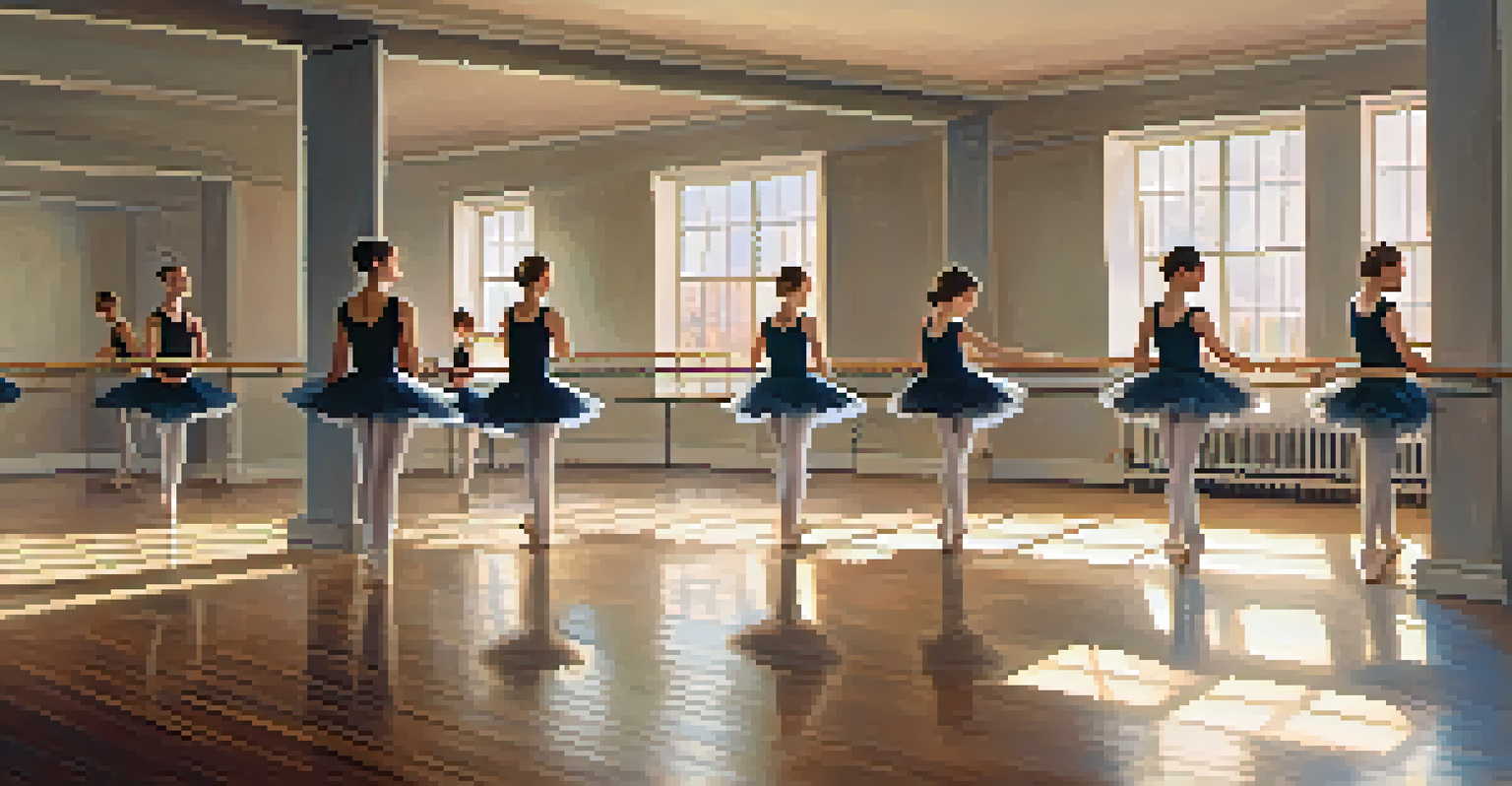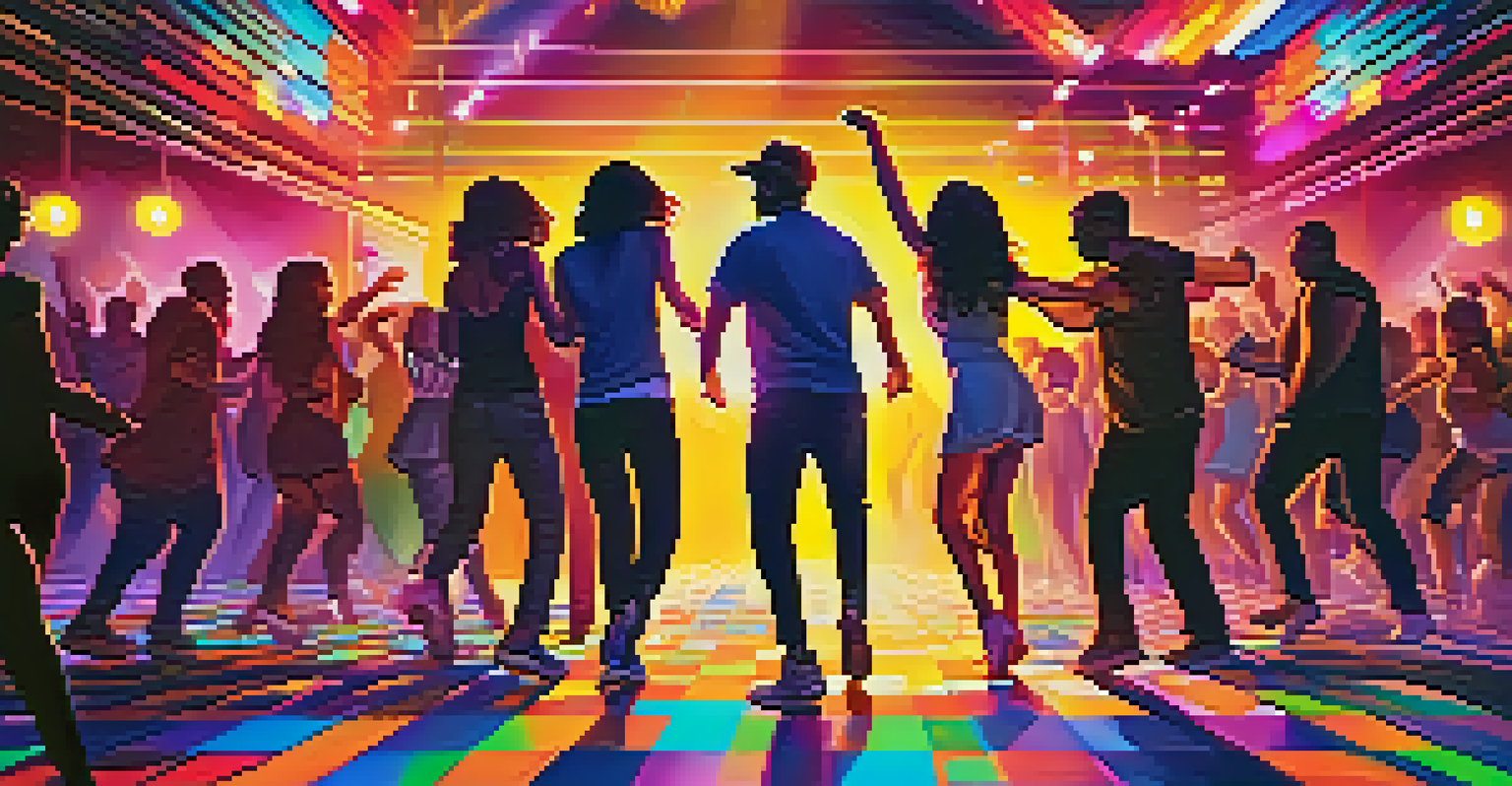Dance Technique Evolution: How Styles Adapt Over Time

The Roots of Dance: A Historical Overview
Dance has been a fundamental aspect of human expression for centuries, with origins tracing back to ancient rituals and celebrations. From the tribal dances of indigenous cultures to the classical ballet of Europe, each style emerges from unique cultural contexts. These historical roots set the foundation for how dance evolves as societies change, reflecting the values, beliefs, and social structures of their time.
Dance is the hidden language of the soul.
For instance, the court dances of the Renaissance period were not just entertainment; they were a display of status and power. As societies progressed, so did the need for dance to adapt to new social norms and artistic movements. This historical evolution showcases the organic interplay between dance and the cultural zeitgeist.
Understanding this historical backdrop allows us to appreciate the layers of complexity in dance today. Each movement carries with it a story of its origins, revealing how dance is not just an art form, but a living history that continues to evolve.
The Impact of Technology on Dance Styles
In the digital age, technology plays a pivotal role in how dance is created, shared, and modified. With the rise of social media platforms, dancers can showcase their work to a global audience in real-time, leading to the rapid spread of new styles. This connectivity encourages collaboration and fusion, as dancers from different backgrounds blend their techniques and traditions, giving birth to hybrid styles.

For example, the viral dance challenges on platforms like TikTok have not only popularized specific moves but have also influenced mainstream choreography. This shift demonstrates how technology can democratize dance, allowing anyone with a smartphone to participate in and shape the conversation around movement. As a result, dance is becoming increasingly diverse and reflective of a collective voice.
Dance Reflects Cultural Evolution
Dance serves as a living history, evolving alongside societal changes and reflecting the values and beliefs of different cultures.
Moreover, technological advancements in training, such as online classes and augmented reality, provide dancers with innovative tools to develop their technique. These resources empower individuals to explore styles and refine their skills, leading to a continuously evolving dance landscape.
Cultural Exchange: How Globalization Shapes Dance
Globalization has significantly influenced dance styles, facilitating a rich exchange of cultural practices. As people migrate and interact, they bring their dance traditions with them, enriching local scenes and fostering new forms. This cultural blending not only celebrates diversity but also creates a dynamic environment where styles can adapt and flourish.
Dancing is creating a sculpture that is visible only for a moment.
Take hip-hop, for example; it originated in the Bronx but has since traveled worldwide, incorporating elements from various cultures. This adaptability has allowed hip-hop to evolve while still retaining its core message of self-expression and resilience. The cross-pollination of styles leads to exciting innovations, as dancers draw inspiration from one another and push boundaries.
Understanding the impact of cultural exchange on dance is vital for appreciating the artistry involved. It highlights how dance is a collaborative effort that transcends borders, making it a universal language that connects people through movement.
The Influence of Social Movements on Dance Styles
Social movements have long influenced dance styles, serving as a powerful medium for expression and activism. Whether it’s the Civil Rights Movement in the United States or the LGBTQ+ rights movement, dance has provided a voice for communities seeking change. Through movement, dancers convey messages of resistance, solidarity, and empowerment, making their art a catalyst for social transformation.
For instance, the emergence of contemporary dance often reflects themes of identity, gender, and politics, incorporating elements of protest into choreography. This blend of artistry and activism demonstrates the capacity of dance to address relevant social issues, inspiring audiences to engage with important conversations. As society evolves, so too does the content and purpose of dance.
Technology Shapes Dance Creation
The rise of technology, particularly social media, democratizes dance by allowing global participation and collaboration, leading to innovative hybrid styles.
Recognizing the role of social movements in dance helps us appreciate the art form as more than just entertainment. It becomes a reflection of our shared struggles and aspirations, reminding us of the power of movement to unite and inspire.
The Role of Education in Dance Technique Evolution
Education plays a crucial role in the evolution of dance techniques, shaping the next generation of dancers and choreographers. Dance schools and institutions provide structured training that not only teaches fundamental skills but also encourages exploration and creativity. This educational framework lays the groundwork for innovation, allowing students to experiment with styles and develop their unique voices.
Moreover, mentorship programs and workshops expose dancers to different techniques and perspectives, fostering a culture of learning and growth. As dancers are introduced to diverse styles, they can adapt and incorporate new elements into their practice. This sharing of knowledge ensures that dance remains a dynamic and evolving art form.
As we look toward the future of dance, the importance of education becomes increasingly clear. It’s not just about preserving traditions; it’s about nurturing creativity and encouraging the evolution of techniques that reflect the world around us.
The Intersection of Dance and Popular Culture
Dance has always been intertwined with popular culture, reflecting and influencing trends in music, fashion, and lifestyle. From the Charleston of the 1920s to the current popularity of K-pop choreography, dance styles often emerge as a response to cultural phenomena. This symbiotic relationship ensures that dance remains relevant, with each new generation adding their flair to existing forms.
For example, the rise of dance-centric reality shows has propelled many styles into the mainstream, making them accessible to wider audiences. These platforms not only showcase talent but also promote diversity in dance, encouraging viewers to engage with different styles. As dance becomes more visible, it adapts to meet the expectations and tastes of contemporary audiences.
Social Movements Influence Dance
Dance acts as a powerful medium for expression and activism, often intertwining with social movements to convey messages of resistance and empowerment.
Recognizing the impact of popular culture on dance helps us understand its evolution as a living, breathing art form. It reminds us that dance is not static; it continuously shifts and transforms, driven by the collective experiences and influences of society.
The Future of Dance: Trends and Predictions
As we look to the future, it's exciting to consider how dance will continue to evolve. Emerging trends indicate that technology will play an even more significant role, with virtual reality and artificial intelligence potentially revolutionizing dance training and performance. These advancements could offer new ways for dancers to express themselves and connect with audiences on a global scale.
Additionally, the growing emphasis on inclusivity and representation in dance is likely to shape future styles. As more voices and perspectives are recognized, we can expect to see a broader range of influences incorporated into choreography. This inclusivity will not only enrich dance but also ensure that it reflects the diverse tapestry of society.

Ultimately, the future of dance is a blank canvas, waiting for the next generation of artists to paint their stories. By embracing change and innovation, dance will continue to adapt and thrive, proving that it is truly a timeless art form.